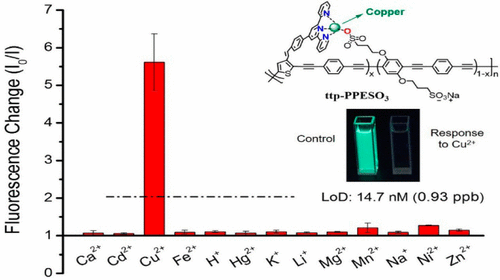Our official English website, www.x-mol.net, welcomes your
feedback! (Note: you will need to create a separate account there.)
Facile Synthesis of Fluorescent Conjugated Polyelectrolytes Using Polydentate Sulfonate as Highly Selective and Sensitive Copper(II) Sensors
ACS Sensors ( IF 8.2 ) Pub Date : 2017-08-23 00:00:00 , DOI: 10.1021/acssensors.7b00400 Wei Wu 1 , Anting Chen 1 , Linyue Tong 1 , Ziqi Qing 1 , Kevin P. Langone 1 , William E. Bernier 1 , Wayne E. Jones 1
ACS Sensors ( IF 8.2 ) Pub Date : 2017-08-23 00:00:00 , DOI: 10.1021/acssensors.7b00400 Wei Wu 1 , Anting Chen 1 , Linyue Tong 1 , Ziqi Qing 1 , Kevin P. Langone 1 , William E. Bernier 1 , Wayne E. Jones 1
Affiliation

|
Fluorescent conjugated polyelectrolytes represent an exciting area of research into new chemosensors. By virtue of their rapid electron and energy transfer paths, these highly correlated, one-dimensional systems have been depicted as “molecular wires” and show “million-fold” sensitivity compared to monomolecular sensor analogs. In this paper, a novel polyelectrolyte sensor, the ttp-PPESO3, has been designed by incorporating terpyridine and sulfonate functional groups into the polyelectrolyte. This specifically tailored sensor has displayed remarkable quenching response toward copper(II) with a detection limit of 14.7 nM (0.93 ppb). It is capable of selectively screening copper without interference from 12 common cations. Molecular modeling suggests that binding occurs through a coordination interaction of the terpyridine and sulfonate. The additional multidentate nature from the sulfonate offers extraordinary chelating ability to the analyte. We anticipate that this unique binding mode will provide insight for the design of future more sensitive and selective systems.
中文翻译:

使用多齿磺酸盐作为高选择性和高灵敏度铜(II)传感器轻松合成荧光共轭聚电解质
荧光共轭聚电解质代表了新型化学传感器研究的一个令人兴奋的领域。凭借其快速的电子和能量传输路径,这些高度相关的一维系统已被描述为“分子导线”,并且与单分子传感器类似物相比显示出“百万倍”的灵敏度。在本文中,一种新型的聚电解质传感器ttp-PPESO 3通过将叔吡啶和磺酸盐官能团掺入聚电解质中来设计R 2。这种专门定制的传感器对铜(II)表现出卓越的淬灭响应,检测极限为14.7 nM(0.93 ppb)。它能够选择性地筛选铜,而不受12种常见阳离子的干扰。分子模型表明结合是通过吡啶和磺酸盐的配位相互作用而发生的。来自磺酸盐的额外多齿性质为分析物提供了非凡的螯合能力。我们预计,这种独特的绑定模式将为未来更敏感和更具选择性的系统设计提供见识。
更新日期:2017-08-24
中文翻译:

使用多齿磺酸盐作为高选择性和高灵敏度铜(II)传感器轻松合成荧光共轭聚电解质
荧光共轭聚电解质代表了新型化学传感器研究的一个令人兴奋的领域。凭借其快速的电子和能量传输路径,这些高度相关的一维系统已被描述为“分子导线”,并且与单分子传感器类似物相比显示出“百万倍”的灵敏度。在本文中,一种新型的聚电解质传感器ttp-PPESO 3通过将叔吡啶和磺酸盐官能团掺入聚电解质中来设计R 2。这种专门定制的传感器对铜(II)表现出卓越的淬灭响应,检测极限为14.7 nM(0.93 ppb)。它能够选择性地筛选铜,而不受12种常见阳离子的干扰。分子模型表明结合是通过吡啶和磺酸盐的配位相互作用而发生的。来自磺酸盐的额外多齿性质为分析物提供了非凡的螯合能力。我们预计,这种独特的绑定模式将为未来更敏感和更具选择性的系统设计提供见识。











































 京公网安备 11010802027423号
京公网安备 11010802027423号